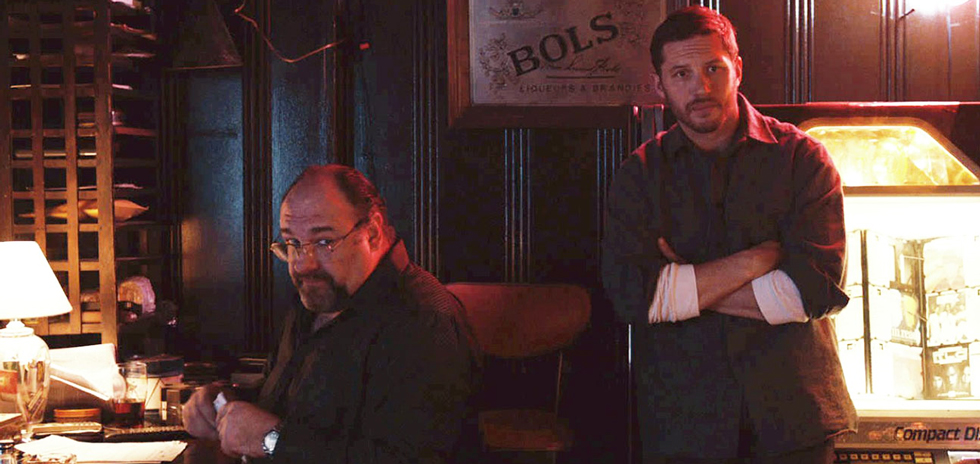
Dennis Lehane’s novels manage to overcome occasionally clichéd plot mechanics and outlandish twists on the basis of a very simple and very powerful skill – the ability to clearly evoke a sense of place and character. Much of this has to do with the setting of the majority of his work, Boston, where Lehane grew up. His familiarity with landmarks, dialect and his ability to effectively capture the relationship between characters and the space around them is something you take away after reading his pulpy Kenzie and Gennaro detective series.1 Ben Affleck’s directorial debut, Gone Baby Gone, was an adaptation of the fourth novel in that series; framed as a standalone narrative it still managed to craft compelling characters and relationships amidst a twisty morality tale told through the guise of a missing persons case. Affleck had the benefit of also having grown up in Boston, whereas the director of The Drop, Belgian Michaël R. Roskam, did not grow up in Brooklyn, where The Drop is set. That’s not to say that you need to be from Boston, or Brooklyn for that matter, to adapt Lehane, but that you need to be able to effectively capture a location or provide a sense of intimate familiarity.2
The plot of The Drop is a jumble of plot strands that don’t really coalesce into anything of meaning over the course of the film’s runtime. We have Bob (Tom Hardy) who tends bar for Marv (James Gandolfini), a once would-be gangster who sold his bar to some Chechens a decade prior and who finds himself in hot water when the bar is robbed.3 There’s also the romantic plotline in which Bob finds a pitbull puppy in a garbage bin belonging to Nadia (Noomi Rapace) and they decide to work together to raise the dog.4 Also in the mix are a shady character who stalks Nadia (Matthias Schoenaerts) and, of course, the titular ‘drop’ which takes up very little of the film as a whole. Put it all together with a somewhat hamfisted final act and you have a lukewarm crime drama that feels padded out with, well, mostly emptiness. It feels like the film is caught between having too much plot or not enough – the two storylines seemingly more akin to a television episode’s A and B plots than something worthy of a full feature. Not to mention that the whole thing feels concocted in a vacuum, playing out against a weakly constructed backdrop.
Part of that is an issue at script level, the producers of the film had Lehane, who penned the script and the short story it is based on, alter the location from Boston to Brooklyn. Presumably this is because a ‘crime story’ tangentially related to New York has broader appeal than one set in New England. Whatever the intention, though, it seems clear that this was quite a major error of judgment. The Brooklyn on display in The Drop does not feel like a real place, it perhaps would have been better off had the setting been Anywhere, USA, much like the vaguely similar and vastly more impressive Andrew Dominik feature Killing Them Softly. The Brooklyn of The Drop is almost entirely white, save for the Eastern European gangsters and the mixed race detective.5 The Brooklyn of The Drop is shot with this movie-poster sheen, strong blues and oranges pushing in from either side of the frame as characters walk down streets. The Brooklyn of The Drop lazily alternates between painting the city with oversaturated vibrant cinematography and a series of dulled greys, shifting sloppily depending on the tonal requirements of each scene.6 Cinematographer Nicolas Karakatsanis (whose praises I sang not even a week ago) mostly phones this one in, save for a few POV shots near the climax that feel less original than borrowed from an episode of Breaking Bad.
Tom Hardy tries on a Brooklyn accent in the film and it’s actually somewhat decent, definitely less grating that his Welsh one in Locke. Accents aside, though, he delivers a mostly strong performance, particularly so as the film reaches its zenith. James Gandolfini doesn’t quite get the send off he deserves here, in fact his performance is a distraction, if anything; his mere presence evokes so many better crime narratives – Killing Them Softly, The Sopranos et al. Noomi Rapace acquits herself, delivering a mostly sincere performance in a sorely underwritten role. Matthias Schoenaerts, of Roskam’s earlier Bullhead, is much of the same, managing to hold his own as a sneering would-be thug, despite being nothing more than cliché on the page. There are some cameos from Ann Dowd, who’s only here for two minutes and deserves better, and James Frecheville of Animal Kingdom, the weak link in that film and only slightly better here.
As a Lehane-penned narrative, The Drop can’t help but be an utter disappointment. It lacks authenticity, its characters, dialogue and setting limply constructed to serve simplistic thematic arcs and well-worn storylines. Its direction is serviceable at best and it loses all real momentum about halfway through when the incongruity of the two plot strands becomes fully apparent. There’s a nice twist near the end that manages to save face but, for the most part, the movie plodded along to its conclusion, a forgettable piece of cinema.
Around the Staff
| Dominic Barlow | |
| Felix Hubble |
